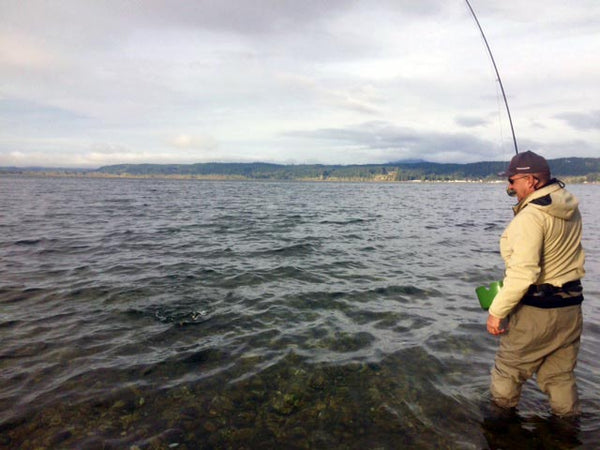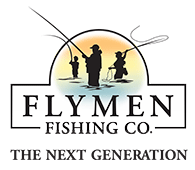How to tackle big water fly fishing

Something about pulling a fish out of a big body of water makes you feel heroic.
Walking up to a big body of water, so big that your cast doesn’t even cover a fraction of the water, can be daunting and even downright discouraging.
You almost feel nervous to make your first cast. Where do I start? How do I tackle this water without a boat?
But when everything comes together and you hook into that fish, you feel like you won the lottery!
Here are a few things to help make swinging your fly rod feel a little more like fishing and a little less like… flailing.
"You just need to put the fly in their kitchen, or in their bedroom."

I've told my guiding clients this countless times while searching for sea run cutthroat in the waters of Puget Sound or walking up to the banks of the Skagit River.
Fish need the same things no matter what kind of water they're living in:
- Fish need food.
- Fish need shelter.
This is as true for most saltwater fish as it is for freshwater fish.
If you're walking onto a body of water like the Missouri River in Craig, Montana and feeling crippled by its size, remember that fish need food, and fish need shelter, and start from there.
Food.

Steelhead fly tied with the Fish-Skull Senyo's Articulated Shank.
We as fly anglers are in the illusion business.
It doesn’t matter what the bait in the water is, whether it be a chum salmon fry here in Washington’s Puget Sound or a finger mullet down in the Everglades in Florida, we just need to present a close enough imitation of it in front of their faces to convince them they're getting a meal .
Fish sipping dries on the Ranch section of the Henry’s Fork in Idaho are some of the “smartest” trout in the world, but if fed the right fly in the right way, those fish eat too!
Whether the water is the Pacific Ocean or grandpa’s farm pond, we need to give these fish a close imitation in a way that they might see at their local drive-thru and set the hook in a way that drives that steel through their lip.
Shelter.

Brita Fordice gettin' it done. Photo by Julie Cyr.
Shelter can be found in many different forms; however, all the best shelter provides two things for the fish:
- A steady food source.
- The ability to escape predators if needed.
In essence, the biggest fish will be living in an apocalyptic bomb shelter with enough canned food to last him five years.
Weed beds.
Weed beds make great structure for fish in big rivers, lakes, and saltwater.
The fish can use the weed beds like a pantry and the next minute pull the weeds over their heads like a kid hiding under the sheets.
Weed beds create great nurseries for all types baitfish such as eels or shiner perch or freshwater food like scuds and leeches.
Tidal rips.
One of the big giveaways when looking for a starting point on a new beach in Puget Sound are sharp points of land.
As the tides rush past these points, they create a seam, or “rip.” These are often good hiding places for all types of fish.
Our salmon use these rips to rest or “stage” until the next tide shift. Sea run cutthroat trout use these rips to feed on baitfish that are using the break in the current.
Current breaks.
The same goes for big rivers. If a rock or point of land breaks the current in a river, it creates a disturbance or “seam” on the surface.
These surface disturbances create shelter for fish to hide under and are a great starting places when breaking down where to fish on a big river.
You'll never be able to catch the fish you can't reach, so stop worrying about them.

Tyler Niemack busy not worrying about the all the fish he couldn't reach.
I think most successful beach anglers and bank anglers anywhere in the world can agree that a big “light-bulb” realization is you can't worry about the water you can't reach.
They're at your feet, dude! 6 reasons to make shorter casts when wade fishing.
Methodically covering the water you can hit with a cast is super important.
You know you're at a disadvantage not being able to reach the outside of the kelp bed, so you better cover the inside well.
The other bonus of this is you'll notice yourself gradually becoming a better caster!
When I have a client who can cast 60 feet but half his cast falls apart or catches the beach on their back cast, I tell them, “shorten it up a bit, let's make every cast count and cover this water perfectly.”
My favorite days on the water are when we get fish in that 40-foot range and eventually my client's cast improves with their confidence to be able to make those 55 to 60-foot casts well every time.
Quick review.
Big water typically equates to faster, stronger fish, and more exploration.
If you're feeling intimidated the next time (maybe even the first time) you walk up to a big body of water, remember:
- You just need to put your fly in the fish's kitchen or bedroom.
- You'll never be able to catch the fish you can't reach, so stop worrying about them and focus on methodically covering the water you can reach.
Hope to see you out there!
Want more articles like this?
Join the Flymen mailing list at the bottom of the page
About Justin Waters:
 Justin grew up on the Gulf coast of Florida fishing for largemouth bass and redfish. He left Florida in pursuit of salmon and steelhead on the Skagit River and Puget Sound in Washington state. He now owns and operates All Waters Fly Fishing, a guide service for salmon and sea run cutthroat in the saltwater of Puget Sound and Hood Canal. Follow him on Instagram: @flyfishingjustinwaters
Justin grew up on the Gulf coast of Florida fishing for largemouth bass and redfish. He left Florida in pursuit of salmon and steelhead on the Skagit River and Puget Sound in Washington state. He now owns and operates All Waters Fly Fishing, a guide service for salmon and sea run cutthroat in the saltwater of Puget Sound and Hood Canal. Follow him on Instagram: @flyfishingjustinwaters


Comments on this post (1)
Thanks .love the imformation and looking forward to more tips
— TELESFORO REYES